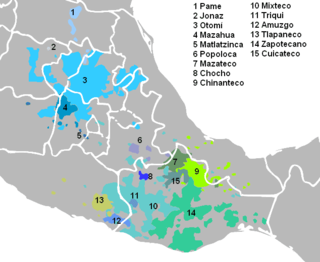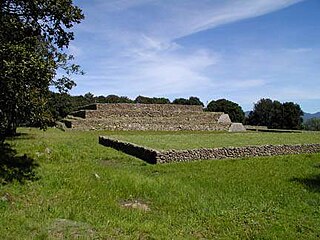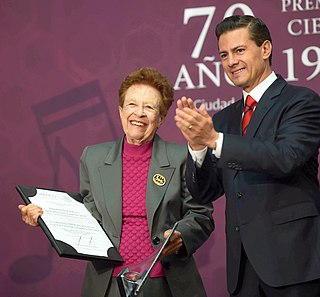
The Oto-Manguean or Otomanguean languages are a large family comprising several subfamilies of indigenous languages of the Americas. All of the Oto-Manguean languages that are now spoken are indigenous to Mexico, but the Manguean branch of the family, which is now extinct, was spoken as far south as Nicaragua and Costa Rica. Oto-Manguean is widely viewed as a proven language family.

The Nahuan or Aztecan languages are those languages of the Uto-Aztecan language family that have undergone a sound change, known as Whorf's law, that changed an original *t to before *a. Subsequently, some Nahuan languages have changed this to or back to, but it can still be seen that the language went through a stage. The best known Nahuan language is Nahuatl. Nahuatl is spoken by about 1.7 million Nahua peoples.

The Otomi are an Indigenous people of Mexico inhabiting the central Mexican Plateau (Altiplano) region.

Otomi is an Oto-Pamean language spoken by approximately 240,000 indigenous Otomi people in the central altiplano region of Mexico. Otomi consists of several closely related languages, many of which are not mutually intelligible. The word Hñähñu has been proposed as an endonym, but since it represents the usage of a single dialect, it has not gained wide currency. Linguists have classified the modern dialects into three dialect areas: the Northwestern dialects are spoken in Querétaro, Hidalgo and Guanajuato; the Southwestern dialects are spoken in the State of Mexico; and the Eastern dialects are spoken in the highlands of Veracruz, Puebla, and eastern Hidalgo and villages in Tlaxcala and Mexico states.

The Oto-Pamean languages are a branch of the Oto-Manguean languages that includes languages of the Otomi-Mazahua, Matlatzinca, and Pamean language groups all of which are spoken in central Mexico. Like all Oto-Manguean languages, the Oto-Pamean languages are tonal languages, though most have relatively simple tone systems. Unlike many Oto-Manguean languages that tend towards an isolating typology, they are morphologically complex headmarking languages with complex systems of conjugational classes both for verbs and nouns, and in the Pamean languages there are highly complex patterns of suppletion.

The Pame languages are a group of languages in Mexico that is spoken by around 12,000 Pame people in the state of San Luis Potosí. It belongs to the Oto-Pamean branch of the Oto-Manguean language family.
Northwestern Otomi is a Native American language of central Mexico.

Conín was a Native American conquistador of the Otomí people, who helped the Spaniards conquer territories in the central part of Mexico during the 16th century. In the Otomí language his name means "Thunder."

Huamango is an early Postclassical archaeological site located about 4 kilometers northwest of the modern city of Acambay in the State of Mexico. The archaeological area is on the San Miguel plateau, in the vicinity of the Peña Picuda hill, at an approximate altitude of 2,850 meters above sea level. It is rich in legends, stories and ancestral traditions.
Sierra Otomia.k.a.Highland Otomi is a dialect cluster of the Otomi language spoken in Mexico by ca. 70,000 people in the highlands of Eastern Hidalgo, Western Veracruz and Northern Puebla. The speakers themselves call the language Yųhų or Ñųhų. Lastra 2001 classifies it as an Eastern Otomi language together with Ixtenco Otomi, Tilapa Otomi, and Acazulco Otomi. The three varieties of Sierra Otomi—Eastern Highland, Texcatepec, and Tenango—are above 70% lexically similar; the Eastern Highland dialects are above 80%, and will be considered here.
The grammar of the Otomi language displays a mixture of elements of synthetic and analytic structures. Particularly the phrase-level morphology is synthetic, whereas the sentence-level is analytic. Simultaneously, the language is head-marking in terms of its verbal morphology, but not in its nominal morphology, which is more analytic. Otomi recognizes three large open word classes of nouns, verbs, and particles. There is a small closed class of property words, variously analyzed as adjectives or stative verbs.
Temoaya Otomi, also known as Toluca Otomi or Otomi of San Andrés Cuexcontitlan, is a variety of the Otomi language spoken in Mexico by ca. 37,000 people in and around the municipality of Temoaya, and in three communities within the municipality of Toluca: San Andrés Cuexcontitlán, San Pablo Autopan and San Cristobal Huichochitlan. The two varieties are quite different. The speakers themselves call the language Ñatho. Lastra (2001) classifies it as a southwestern dialect along with the dialects of Mexico state. Lastra also notes that the endangered Otomí dialect of San Felipe in eastern Michoacán is most similar to the Otomí spoken in San Andrés Cuexcontitlan.

Yolanda Lastra de Suárez is a Mexican linguist specializing in the descriptive linguistics of the indigenous languages of Mexico. She obtained her PhD degree in 1963 from Cornell University, her dissertation written under the guidance of Charles F. Hockett treating the syntax of Cochabamba Quechua in Bolivia. She was married to Argentinian linguist Jorge A. Suárez (1927-1985).
Classical Otomi is the name used for the Otomi language as spoken in the early centuries of Spanish colonial rule in Mexico and documented by Spanish friars who learned the language in order to catechize the Otomi peoples. During the colonial period, many Otomis learned to write their language in Roman letters. As a consequence, a significant number of documents in Otomi, both secular and religious, exist from the period, and the most well-known documents are the Codices of Huichapan and Jilotepec. Text in classical Otomi is not easily accessible since the Spanish speaking friars failed to differentiate the varied vowel and consonant sounds of the Otomi language.
Central Otomi is a Native American language spoken by 10,000 in San Felipe Santiago and in several neighboring towns in the Mexican state of Mexico, such as Chapa de Mota and Jilotepec de Abasolo. Also called 'State of Mexico Otomi', there are other varieties spoken in the state, such as Temoaya Otomi. The autonym is Hñatho or Hñotho.
Ixtenco Otomi, also known as Tlaxcala Otomi, is a native American language spoken in the town of San Juan Bautista Ixtenco in the state of Tlaxcala, Mexico. It has been classified as Eastern Otomi by Lastra (2006). Lastra considers Ixtenco Otomí to be a very conservative dialect.
Santa Ana Hueytlalpan Otomi is a native American language spoken in Santa Ana Hueytlalpan town of Tulancingo de Bravo municipality of Hidalgo, Mexico. It has been classified as Eastern Otomi by Lastra (2006), but is not included in Ethnologue.
San Jeronimo Acazulco Otomi, or Ocoyoacac Otomí, is a moribund and seriously endangered dialect of the Otomi language spoken by a hundred or so people in the town of San Jerónimo Acazulco in Ocoyoacac, Mexico State.

San Jerónimo Acazulco is a town and community in the municipality of Ocoyoacac, Mexico State, Mexico. Once an agricultural community, the economy of the ejido is now primarily based on tourist commerce. It is within La Marquesa National Park.
Santiago Tilapa is a town inside the municipality of Tianguistenco in Mexico. It was an indigenous settlement with people who speak Otomi.